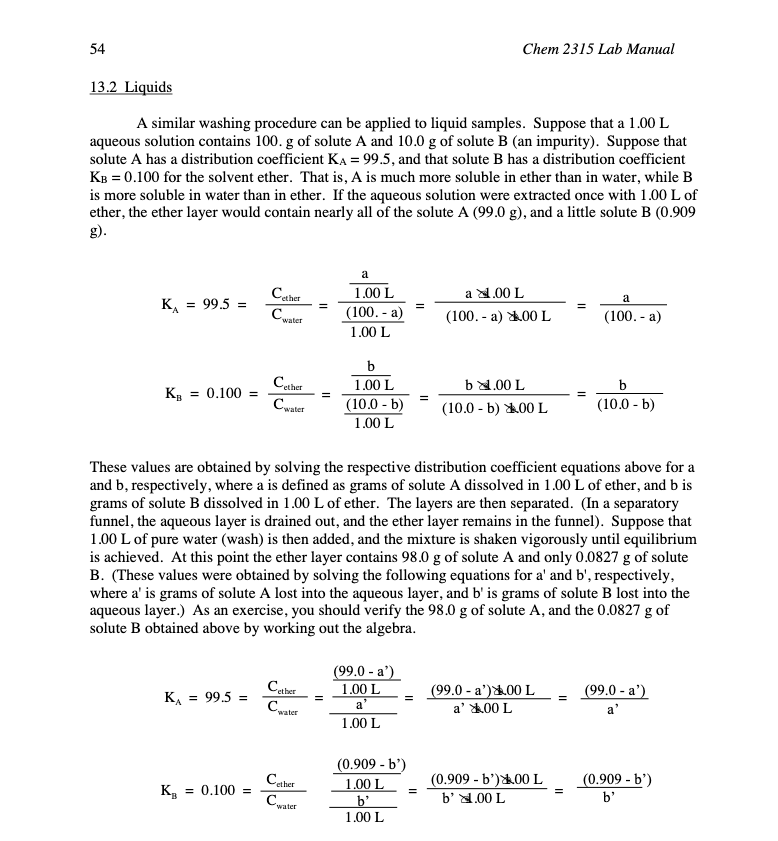Assume that 1.00 mL (1.02 g) of crude product mixture is obtained from the reaction before the washing steps, and the distribution constant of the product mixture in brine is K = (Cmixture/Cbrine) = 50.0. Assuming that after mixing the product mixture volume is still 1.00 mL (i.e., the volume lost is small), and the volume of the first brine wash layer is 2.00 mL. What mass (grams) of product mixture is lost (dissolves) in the first brine wash? (See Technique 13.2, p 53.) Show work.
Assume that 1.00 mL (1.02 g) of crude product mixture is obtained from the reaction before the washing steps, and the distribution constant of the product mixture in brine is K = (Cmixture/Cbrine) = 50.0. Assuming that after mixing the product mixture volume is still 1.00 mL (i.e., the volume lost is small), and the volume of the first brine wash layer is 2.00 mL. What mass (grams) of product mixture is lost (dissolves) in the first brine wash? (See Technique 13.2, p 53.) Show work.
Chemistry
10th Edition
ISBN:9781305957404
Author:Steven S. Zumdahl, Susan A. Zumdahl, Donald J. DeCoste
Publisher:Steven S. Zumdahl, Susan A. Zumdahl, Donald J. DeCoste
Chapter1: Chemical Foundations
Section: Chapter Questions
Problem 1RQ: Define and explain the differences between the following terms. a. law and theory b. theory and...
Related questions
Question
Assume that 1.00 mL (1.02 g) of crude product mixture is obtained from the reaction
before the washing steps, and the distribution constant of the product mixture in brine is
K = (Cmixture/Cbrine) = 50.0. Assuming that after mixing the product mixture volume is
still 1.00 mL (i.e., the volume lost is small), and the volume of the first brine wash layer
is 2.00 mL. What mass (grams) of product mixture is lost (dissolves) in the first brine
wash? (See Technique 13.2, p 53.) Show work.

Transcribed Image Text:54
13.2 Liquids
A similar washing procedure can be applied to liquid samples. Suppose that a 1.00 L
aqueous solution contains 100. g of solute A and 10.0 g of solute B (an impurity). Suppose that
solute A has a distribution coefficient KA = 99.5, and that solute B has a distribution coefficient
KB = 0.100 for the solvent ether. That is, A is much more soluble in ether than in water, while B
is more soluble in water than in ether. If the aqueous solution were extracted once with 1.00 L of
ether, the ether layer would contain nearly all of the solute A (99.0 g), and a little solute B (0.909
КА = 99.5 =
KB = 0.100 =
KA
= 99.5 =
Cather
Cwater
KB = 0.100 =
Cether
Cater
Cether
Cater
Cether
=
Cwater
a
1.00 L
(100.- a)
1.00 L
b
1.00 L
(10.0 - b)
1.00 L
These values are obtained by solving the respective distribution coefficient equations above for a
and b, respectively, where a is defined as grams of solute A dissolved in 1.00 L of ether, and b is
grams of solute B dissolved in 1.00 L of ether. The layers are then separated. (In a separatory
funnel, the aqueous layer is drained out, and the ether layer remains in the funnel). Suppose that
1.00 L of pure water (wash) is then added, and the mixture is shaken vigorously until equilibrium
is achieved. At this point the ether layer contains 98.0 g of solute A and only 0.0827 g of solute
B. (These values were obtained by solving the following equations for a' and b', respectively,
where a' is grams of solute A lost into the aqueous layer, and b' is grams of solute B lost into the
aqueous layer.) As an exercise, you should verify the 98.0 g of solute A, and the 0.0827 g of
solute B obtained above by working out the algebra.
(99.0 - a')
1.00 L
a'
1.00 L
(0.909 - b')
1.00 L
b'
1.00 L
Chem 2315 Lab Manual
=
=
a 1.00 L
(100. a) 00 L
b 1.00 L
(10.0-b) 00 L
(99.0 - a') 00 L
a' 00 L
(0.909 - b')00 L
b' 1.00 L
=
=
a
(100.- a)
b
(10.0 - b)
(99.0 - a')
a'
(0.909 - b')
b'
Expert Solution
This question has been solved!
Explore an expertly crafted, step-by-step solution for a thorough understanding of key concepts.
This is a popular solution!
Trending now
This is a popular solution!
Step by step
Solved in 4 steps with 2 images

Knowledge Booster
Learn more about
Need a deep-dive on the concept behind this application? Look no further. Learn more about this topic, chemistry and related others by exploring similar questions and additional content below.Recommended textbooks for you

Chemistry
Chemistry
ISBN:
9781305957404
Author:
Steven S. Zumdahl, Susan A. Zumdahl, Donald J. DeCoste
Publisher:
Cengage Learning

Chemistry
Chemistry
ISBN:
9781259911156
Author:
Raymond Chang Dr., Jason Overby Professor
Publisher:
McGraw-Hill Education

Principles of Instrumental Analysis
Chemistry
ISBN:
9781305577213
Author:
Douglas A. Skoog, F. James Holler, Stanley R. Crouch
Publisher:
Cengage Learning

Chemistry
Chemistry
ISBN:
9781305957404
Author:
Steven S. Zumdahl, Susan A. Zumdahl, Donald J. DeCoste
Publisher:
Cengage Learning

Chemistry
Chemistry
ISBN:
9781259911156
Author:
Raymond Chang Dr., Jason Overby Professor
Publisher:
McGraw-Hill Education

Principles of Instrumental Analysis
Chemistry
ISBN:
9781305577213
Author:
Douglas A. Skoog, F. James Holler, Stanley R. Crouch
Publisher:
Cengage Learning

Organic Chemistry
Chemistry
ISBN:
9780078021558
Author:
Janice Gorzynski Smith Dr.
Publisher:
McGraw-Hill Education

Chemistry: Principles and Reactions
Chemistry
ISBN:
9781305079373
Author:
William L. Masterton, Cecile N. Hurley
Publisher:
Cengage Learning

Elementary Principles of Chemical Processes, Bind…
Chemistry
ISBN:
9781118431221
Author:
Richard M. Felder, Ronald W. Rousseau, Lisa G. Bullard
Publisher:
WILEY